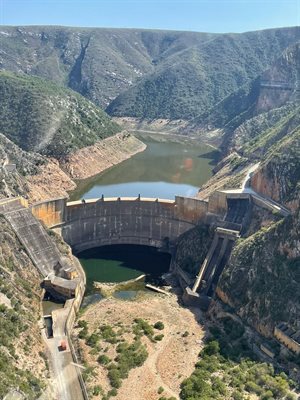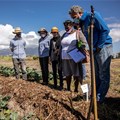Gamtoos River Valley buckling under drought as Kouga Dam drops below 7%

The Gamtoos Irrigation Board (GIB) has warned water users that it cannot supply water adequately below the 3% water mark. The board oversees the dam’s water distribution.
Known for its citrus, cash crop, and dairy farming, the Gamtoos River Valley is buckling under a years-long drought, bringing farmers to their knees. Due to the dwindling water reserves, the 132 agricultural water users who rely on the dam for irrigation have been able to draw just 20% of their annual water quota since last July.
“The lowest release level of the dam is 3.1%,” said Rienette Colesky, CEO of the irrigation board. “We will, however, not be able to sustainably supply water at that level.”
Colesky said the Nelson Mandela Bay and Kouga municipalities’ drawings from the dam were curbed to just 30% and 70% of their full water allocations, respectively. Both were honouring these restrictions, she said.
Citrus harvest endangered
“This situation endangers the citrus harvest for many farmers who might not be able to water their crops further and who do not have access to alternative sources, such as boreholes,” she said. Even when farmers substituted their water supply by drilling boreholes, that water quality was not always suitable for agricultural use, she added.
“The situation was already dire for our cash crop and dairy farmers from the start of the water year, as a 20% availability of their full water allocations has had a devastating effect on the planting of cash crops and the watering of pastures for dairy farming.”
Many farmers have had to outsource the planting of their crops and grazing of their cattle to areas where water is more plentiful.
Cattle and citrus farmer in the valley Tertius Meyer said some farmers had already used up their water allocations for the 2020/21 water year, which ends in June, leading to their supply from the dam being discontinued.
Condition of the cattle worsening
“Some farmers are helping their neighbours [with water]. Some are spending a fortune bringing in water in tankers just to keep their orchards alive,” said Meyer, who is also chairman of the GIB. “One can see the condition of the cattle worsening, as there is very little food for them, forcing farmers to either sell off their livestock or rent grazing in areas with water and move their herds.
“As you drive through the valley, you can see the trees are dry. The fruit size will be affected, which means there will be an abundance of smaller fruit this season.”
A fellow farmer in the valley, Khaya Katoo, said he had had to drill boreholes to supplement his water supply from the dam.
“We need to mix the borehole water with the dam water [to make it suitable for irrigation], but the dam water is not enough at the moment,” he said. “Our quota will be used up very soon, but we have fruit which needs harvesting. That’s a worry, as it’s hot and the trees need a lot of water.
“We have reduced our irrigation scheduling to ensure that the youngest trees get enough water and survive,” said Katoo, adding that he had cut back on water usage by 30%, which would mean a harvest of smaller sized fruit later this year.
Affecting fruit size, tonnage per hectare
Noel le Roux farms with his brother in the valley, and together they provide fresh produce for leading retailers nationwide. Le Roux said the scarcity of irrigation water meant they had had to use their reduced water quota “to keep the citrus going because it’s a permanent crop” which makes up 40% of the business.
“We have had to hire ground in areas like Uitenhage, Elandsrivier and Kareedouw – and even as far afield as Steynsburg and Hofmeyr – to plant our fresh produce, to keep our contracts with the grocery chains,” he said.
“We are trying our utmost to keep our permanent workforce without making retrenchments, although there have been some already. If we don’t get decent rains in the coming weeks, it will have a big effect on our fruit size and our tonnage per hectare of our citrus.”
Port Elizabeth Weather Office spokesperson Garth Sampson said the region was headed “for one of the driest summers on record”.
Historically, he said, the highest incidence of rain over the dam’s catchment area occurred from March to October. However, forecast models were not clear on whether there would be decent rains in the coming months or not, he added.









